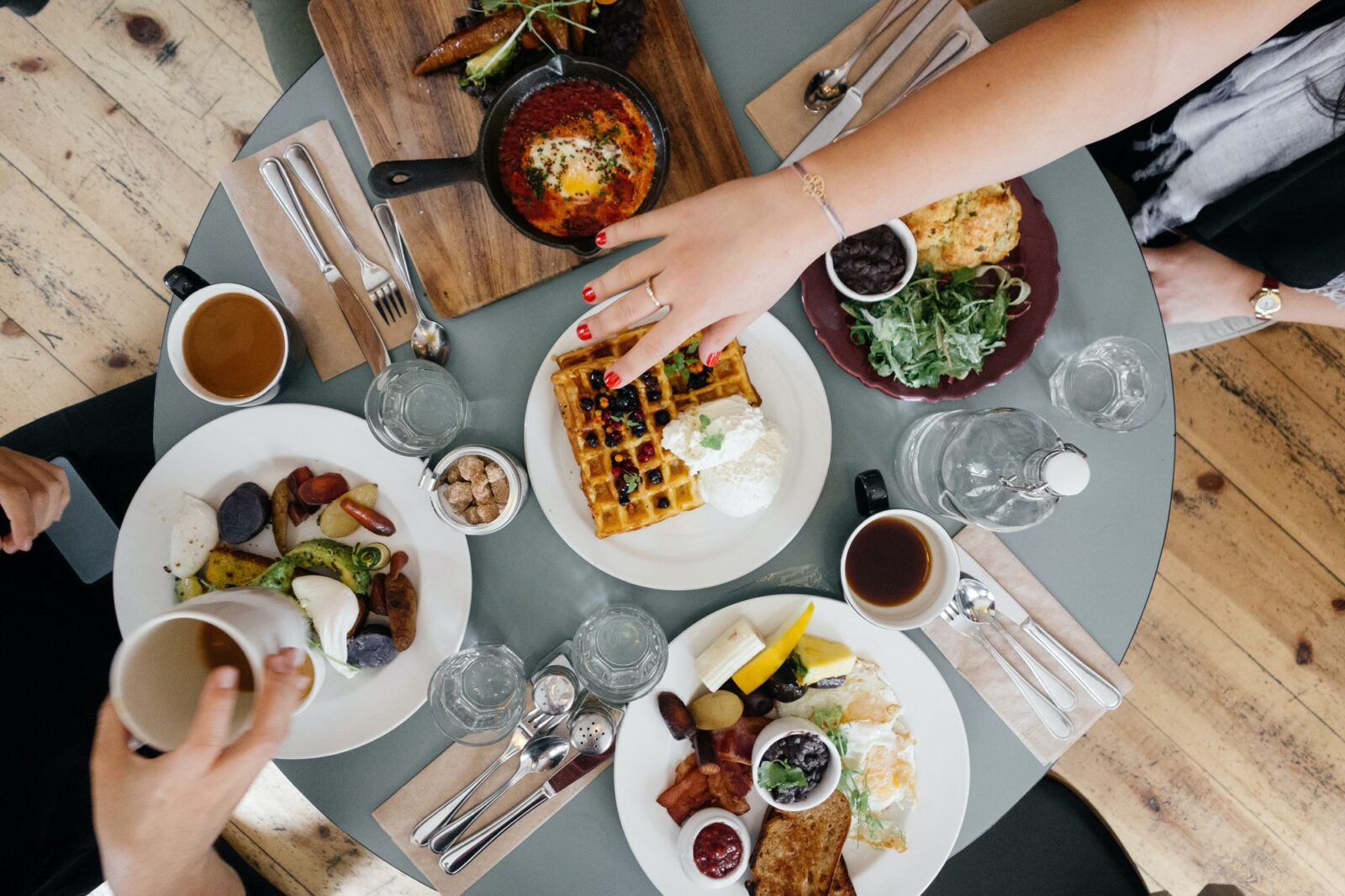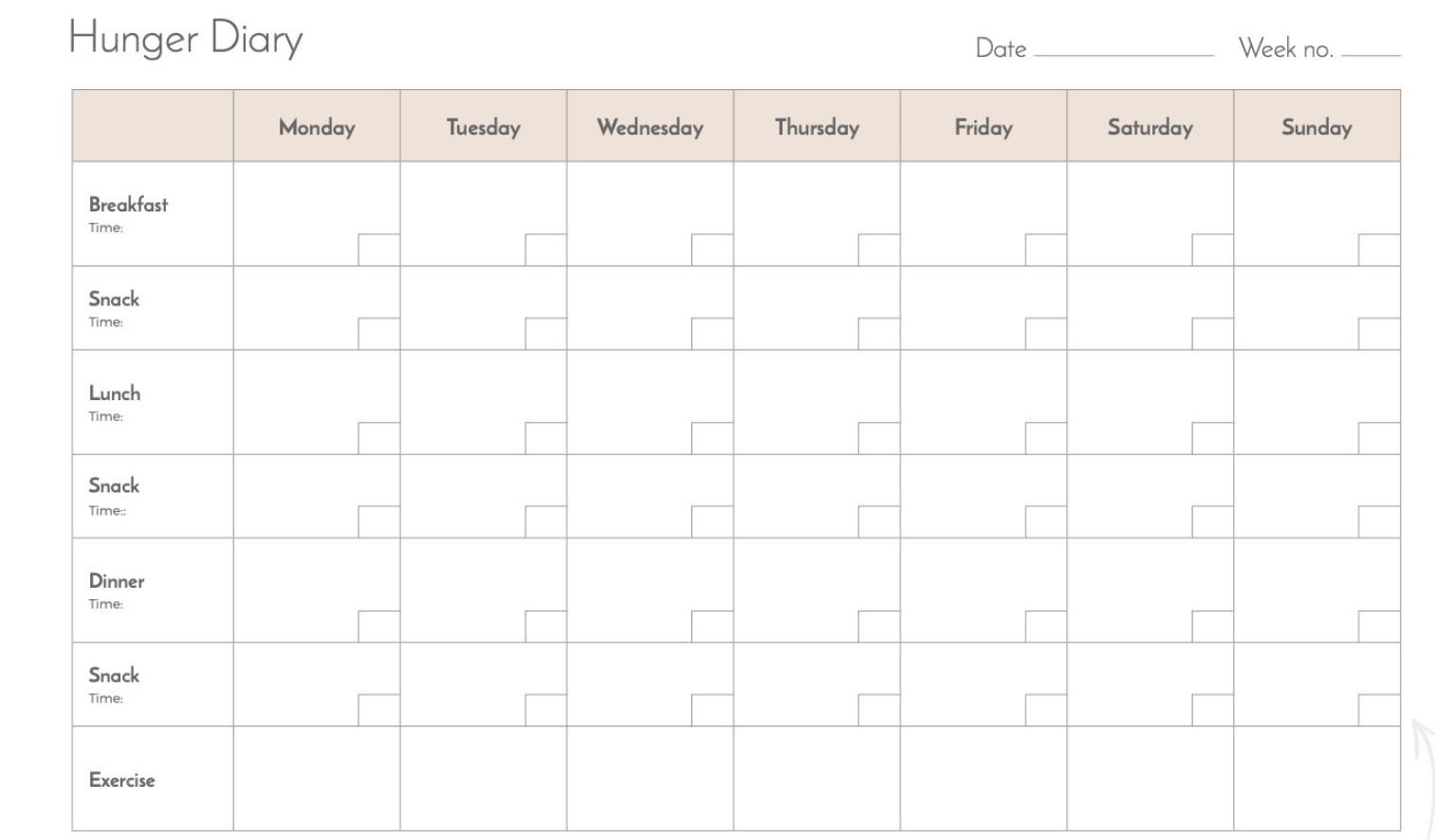First up, the hunger scale is NOT a food tracker (like dieting nonsense). It’s a tool to record your hunger. Learning how to use it was a game-changer for me and helped me quit dieting for good.
I have no doubt that you’ll also feel amazing once you tune into your hunger and eat according to your lovely body’s needs.
But let’s start at the beginning…
What is intuitive eating?
From the moment you were born, you intuitively knew how much food your body needed to get enough energy. You cried when you were hungry and stopped eating when you were satisfied. You did not need a meal plan to tell you the best way to eat for your blood type or a diet book to guide your eating.
You were born understanding how to best fuel your body so that you thrived, grew strong and healthy.
However, as you grew older, all of this changed. Silly diet rules and unsolicited nutrition advice made intuitive eating almost impossible.
Learning about intuitive eating again is about getting back that very deeply intelligent part of you that knows exactly how to best feed yourself. You don’t need a meal plan or a diet guru to tell you how or what to eat.
All you have to do is check in with your hunger and how food makes you feel.

How to know when you’ve eaten enough
You instinctively know when you are tired and when you need the bathroom.
But did you know that a very similar mechanism can help you regulate your weight without you even trying?
You may even be familiar with this system.
It is called appetite.
Your brain and stomach are in constant communication with one another. A super-smart section of your brain (called the hypothalamus) receives chemical messages from your gut letting you know when you are hungry.
Your body translates these messages and determines that it is time for food.
Perhaps you have noticed that some days you are ravenous? On these days, your body is using more energy. On days when you are less hungry (and may even forget about food), your body is burning less fuel.
Hunger is your body’s way of letting you know how much or how little to eat.
We all have a set-point weight(s). At this weight, your body functions at its best – you feel energised and nourished.
Your body is savvy and wants to help you stay at this set point. When you ignore the natural cues of hunger and fullness, you get in the way of your body’s efforts.
Research confirms that when you get too hungry (ravenous), you are more likely to turn to sugar and refined carbs to boost your energy levels.
However, when you tune into your hunger and eat appropriately, your body will instinctively let you know when it is time to stop.
When you learn to respond to signals of hunger, fullness, and appetite your body will be guiding you to make healthy, enjoyable choices. No more counting calories or obsessing about food.
Instead of eating your meals by the clock, tune into the messages from your body. Get back in touch with your innate sense of hunger and appetite. This will be the best indicator of when your body needs food.

Can you lose weight with intuitive eating?
If you come across intuitive eating success stories that highlight weight loss, or see a health professional promote intuitive eating before and after photos, please be suspicious.
In my humble opinion, before and after photos should be banned (they’re utter nonsense!), let alone be used in the context of intuitive eating.
It’s important to understand that intuitive eating is NOT a diet. It’s about changing your mindset about food and learning how to eat normally again after years of restricting food and eating by the clock. It’s about learning how to know when you’ve eaten enough and when you need to eat more. Not based on the words of an influencer or diet guru, but by listening to the signals that your smart body is sending you.
To answer the question: yes, you might lose weight with intuitive eating. Some people do. But you might not lose weight with intuitive eating. You see, weight loss isn’t really the goal. The real benefit is feeling normal and relaxed with eating. Creating a healthy relationship with your body and food. No more counting calories. Freedom from food rules. It’s crucial to focus on your health, not weight loss.
I lost 20kg (45lbs) when I stopped dieting. What you might not know is that it took four years to lose that weight. Averaged out over the four years, that means I lost just 100g (3.5oz) per week. So if I started intuitive eating to lose weight, I would have given up when I barely lost anything each week. Luckily, my goal wasn’t to lose weight but to change my habits and be healthy – and it worked.
Creating a healthy relationship with food isn’t a quick fix and there is no end date to health. It’s an ongoing work in progress, with moments when you’re doing all the healthy stuff followed by big weekends and busy living and not enough time for you. There really is no “after” photo because health is lifelong work.
Unsure if you’re on a diet or eating intuitively? No surprise! As more and more diet companies try and commercialise the principles of intuitive eating, we need to be able to spot the clear warning signs to look out for. I tell you everything you need to know in this episode of my podcast No Wellness Wankery.

How to use the Hunger Scale
It’s time to get into the juicy bit…enter the Hunger Scale.
Learning how to use this tool has been incredibly helpful for my recovery from Binge Eating Disorder. If you want to learn how to practice intuitive eating, it will become your new best friend as well!
The Hunger Scale is a simple tool that can help you work out just how hungry you are. Ranking your hunger on a scale from 0-10 before and after you eat, can help you better respond to your appetite and be an intuitive eater.
Practice asking yourself “Am I hungry?” before eating. You won’t get it spot-on every time (especially if you’ve been dieting), but it gets easier with practice. Pinky promise!

Here’s what I want you to do over the next week:
- Print out my hunger diary. Click here to download.
- Rank your hunger on a scale of 0-10 before and after eating.
- Try to eat when you reach a 3 on the scale. It’s time to stop when you reach 7.
How to start eating intuitively
Using the hunger scale will help you tune into your body and teach you how to eat intuitively. You might wonder what exactly you’ll learn from tracking your hunger for a week…stick around here, I’ve got a few more strategies up my sleeve, that I’m stoked to share with you!
Once you started tracking your hunger, start with these 3 easy steps.
Step 1: Are you eating when you’re hungry?
Find out whether you eat when you’re actually hungry.
☝️ Use a highlighter to underline any hunger scores lower than 2, indicating when you got a little too hungry.
✌️ Then use a different coloured highlighter to circle hunger scores above 3, indicating when you’ve eaten before you were hungry.
Now, let’s get to the juicy bits (aka learnings that will change your life in the long run)…
- If you’re getting too hungry (0-2) more than once a week, try to make your mealtime a little earlier and carry nutritious snacks. Alternatively, you may want to eat a little more at your previous meal.
- If you’re eating before you’re comfortably hungry (>3), practice waiting an extra half hour. Alternatively, try eating slightly less at your previous meal.
Occasionally you’ll eat before you’re hungry or eat past satisfaction, but it’s important to notice if it happens daily or several times during the week.

Step 2: Look for patterns
You may snack at the same time each day or become overly hungry mid-morning, and not yet recognise the pattern. Simply becoming aware of patterns can help you make a change.
❔ Do you eat because you’re scared of getting hungry?
Ask yourself, what is the worst-case scenario? Will I be slightly uncomfortable for a short period? Practice letting yourself experience hunger in a safe environment, for example on the weekend, when you’re at home and don’t have other plans.
❔ Are you consistently too hungry (0-1) before eating?
Eat earlier in the day, have a snack between meals or eat a little more at the previous meal.
❔ Are you consistently not hungry enough (5-10) before a ‘meal time’?
Wait a little longer before eating or eat a little less at the previous meal.
Did you know that you can also track your hunger in the Hunger Check-In tool from my app Back to Basics?
It allows you to rate your hunger before eating and your fullness after eating with the click of a button, then automatically reveals patterns & strategies to help you reconnect with your body.
If you are curious about how it works, you can start a FREE 7-day trial and check it out.
Step 3: Count your serves of veggies and fruit
Were you taught that a banana has ‘too many carbs’ or that you can only eat low sugar fruit or veggies!? If so, I’m so sorry!
The diet industry has taught us to fear perfectly healthy food like fruit and vegetables. As a result, the list of ‘allowed’ foods becomes so teeny, tiny that we’re left wondering “Wtf am I even allowed to eat anymore!”
It’s not OK. Instead of creating a list of foods to avoid (which only leads to more cravings and binge eating) ‘crowding’ in more vegetables and fruit is a simple way to feel better, without the deprivation.
Count your serves of fruit and veggies – I challenge you to slip in one additional serve today.
A serve of veg or fruit is about the size of your fist (or about 1 cup). I promise that this will benefit your entire body and help you feel good (yip, been there, done that).
Here are a few ideas:
- Add a handful of baby spinach to your dinner plate or smoothie
- Apple with nut butter
- Snack on some cherry tomatoes, a carrot, or cucumber
- Seek out the most veggie-rich meal on the menu at a cafe
- Strawberries chopped and served with greek yoghurt
- Tomatoes and babby boccocini
- A banana sliced into muesli
And for the record. You are allowed to eat a full banana. You don’t have to stick to only berries. Potatoes are not a ‘treat’ food. And yes, pickles count toward your daily veggie serves. So does frozen produce. And legumes like beans count as well!

Using the hunger scale to find food freedom
I really hope learning how to use the hunger scale helps you overcome your fear of intuitive eating. Now that you’re aware of your hunger throughout the day and your eating habits throughout the week, you can start making small tweaks that will have life-changing effects. As you practice listening to your hunger, you’ll get to understand your body more and become more responsive.
Safe to say, ditching diets and really digging into the concept of intuitive eating is going to be a total game-changer for you, just like it was for me.
Do you want to learn more about being an intuitive eater?
The Hunger Check-In tool in my app Back to Basics makes rating and learning about your hunger so much easier. Plus, you get plenty of deliciously simple recipes, home workouts that are actually fun, expert advice to help you stay on track, and soooo much more.
